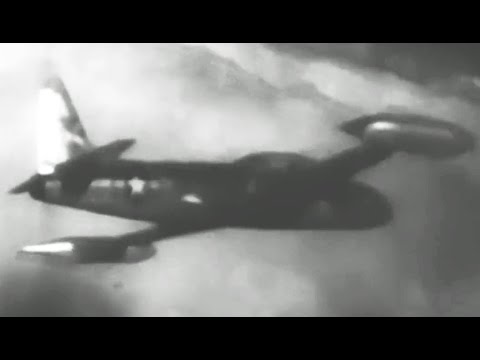US Air Force History playlist:
Aircraft playlist:
more at
“AF DEVELOPMENT BETWEEN WW II AND KOREAN WAR, INCLUDING SCENES OF PROMINENT AIRCRAFT AND PERSONALITIES OF THAT PERIOD. COVERS BERLIN BLOCKADE, SHOWS MAJOR MILESTONE DEVELOPMENTS SUCH AS THE X-1 AND NEWSMAKING FLIGHTS SUCH AS THE HAWAII-TO-CARIO FLIGHT IN 1946.”
Reupload of a previously uploaded film with improved video & sound.
Public domain film from the US National Archives, slightly cropped to remove uneven edges, with the aspect ratio corrected, and one-pass brightness-contrast-color correction & mild video noise reduction applied.
The soundtrack was also processed with volume normalization, noise reduction, clipping reduction, and/or equalization (the resulting sound, though not perfect, is far less noisy than the original).
…Cold War and war in Korea
In practice, the Army Air Forces became virtually independent of the Army during World War II, but its leaders wanted formal independence. Over the continuing objections of the Navy, the United States Department of the Air Force was created by the National Security Act of 1947. That act became effective September 18, 1947 when the first secretary of the Air Force, Stuart Symington, took office. In 1948, the service chiefs agreed on usage of air assets under the “Key West Agreement”.
On 16 September 1947, the Army Air Forces became the United States Air Force as a separate and equal element of the United States armed forces. The fledging Air Force quickly established its own identity. Army Air Fields were renamed Air Force Bases and personnel were soon being issued new uniforms with new rank insignia. Once the new Air Force was free of army domination, its first job was to discard the old and inadequate ground army organizational structure. This was the “Base Plan” where the combat group commander reported to the base commander, who was often regular army, with no flying experience.
General Carl A. Spaatz established a new policy, “No tactical commander should be subordinate to the station commander.” This resulted in a search for a better arrangement. The commander of the 15th Air Force, Major General Charles Born, proposed the Provisional Wing Plan, which basically reversed the situation and put the wing commander over the base commander. The USAF basic organizational unit became the Base-Wing.
Under this plan, the base support functions — supply, base operations, transportation, security, and medical were assigned to squadrons, usually commanded by a Major or Lt. Colonel. All of these squadrons were assigned to a Combat Support Group, commanded by a Base Commander, usually a Colonel. Combat fighter or bomber squadrons were assigned to the Combat Group, a retention of the USAAF Group. All of these groups, both combat and combat support, were in turn assigned to the Wing, commanded by a Wing Commander. This way the Wing Commander commanded both the combat operational elements on the base as well as the non-operational The Wing Commander was an experienced air combat leader…
The USAAF Wing then was redesignated as an Air Division, which was commanded Brigadier General or higher, who commanded two or more wings usually, but not always, on a single base. Numbered Air Forces (NAF) commanded both Air Divisions or Wings directly, and the NAF was under the Major Command (SAC, TAC, ADC, etc.).
After World War II, relations between the United States and the Soviet Union began to deteriorate, and the period in history known as the Cold War began…
The first test for the USAF during the Cold War came in 1948, when Communist authorities in East Germany cut off road and air transportation to West Berlin. The USAF, along with the Royal Air Force (RAF), supplied the city during the Berlin airlift under Operation Vittles, using C-54 Skymasters. The efforts of the USAF and British RAF saved the city from starvation and forced the Soviets to back down in their blockade.
Conflict over post-war military administration, especially with regard to the roles and missions to be assigned to the Air Force and the U.S. Navy, led to an episode called the “Revolt of the Admirals” in the late 1940s, in which high-ranking Navy officers argued the case for carrier-based aircraft rather than strategic bombers.
In 1947, the USAF began Project Sign, a study of unidentified flying objects what would be twice revived (first as Project Grudge and finally as Project Blue Book) and which would last until 1969…

